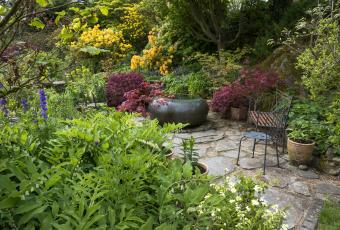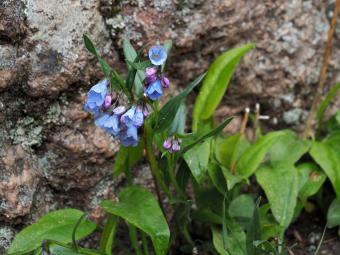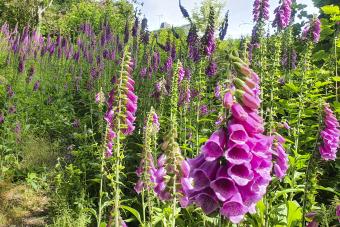
There's no question that the sun is one powerful force in the gardening world, but it's not the only thing that can breed life. Shade gardens are an awesome way to take advantage of any naturally shady areas in your yard. Diversify your yard with unique plants and flowers by figuring out which shade-loving flora appeal to you as well as how to keep them happy with the most cover possible.
Create Natural Shade Using Flora

It's perfectly normal to have a sun-exposed back or front yard. But, having a little shade coming in from your current landscape design doesn't mean you're primed for making a shade garden. One way to create natural shade is to increase the number of trees, large shrubs, and creeping vines in a certain area of your property. This can be time consuming, but it's well worth the wait since you'll have consistent shade for decades.
Create Artificial Shade Using Ornamentation

If you don't have the space, money, or time to plant full-sized trees, then you might want to use decorative elements to create your shade instead. One of the most popular choices is a pergola, which (when combined with vining/creeping plants) can create a nice amount of soft shade for a garden to grow under. In addition to pergolas, you can also put in a sun canopy, latticework, or decorative umbrellas.
Around your installations, add large rocks and other decorative pieces to add some small-time shade to the overall area. Also, these ornamentations work best when combined with some other form of vegetative shade, such as bushes and creeping plants.
Assorted Plants to Grow a Robust Shade Garden

Once you've got the controlled, consistent shade, you're ready to start planting. When it comes to home gardening, most people are familiar with full-sun or partial-sun plants that bloom in the spring and summer. But there's a whole other world of shade-loving flora just waiting to be planted, and these are just some of the many options you can experiment with.
Lungwort

A spring blooming perennial, Lungwort is a great addition to any shade garden. They bloom beautiful, teeny flowers and only grow up to a foot tall. They can survive in most growing zones and don't require too much maintenance.
When planting your lungwort, make sure you get it in the ground during late summer and early fall in well-draining soils. And, if you're planting them underneath trees for your shade garden, make sure you give it a little extra water so that it doesn't compete with the massive tree roots sucking up all the moisture.
Foxglove

Foxglove is a beautiful perennial the plant whose vertical flowers attract all sorts of good pollinators. Not only are they visually arresting, they also grow to between 3-5' tall. Unlike some shade plants, foxglove can't thrive in absolute shade. They need a good balance between shade and sun, so plant your foxgloves on the border of your shade gardens. This'll let them leech off the sun and provide extra shade to the ground cover plants that need a ton of it.
When planting foxgloves in the late summer, make sure you're putting them in well-drained soil. And, as throughout the blooming season, make sure to deadhead the old flowers so that they continue growing big and beautiful.
Leopard Plant

Leopard plants, despite what their name implies, are big, fibrous-looking evergreens. These perennials are like foxgloves in that they enjoy partial shade and sun. Similarly, they're a wet-loving plant and can't be allowed to get too dry, else they'll die. Plant your leopard plants in the ground in the early spring around the borders of your shade garden. Because of their big, shiny leaves, they work really well alongside bright flowering plants to add volume and texture.
Coral Bells

Coral bells get their name from their ruffled, coral-like leaves. These perennials love partial shade and perform well in milder growing zones. A smaller evergreen, coral bells need to be planted in well-draining soil that's slightly acidic. After watering them well throughout their first year, they won't need too much attention.
Because of their interesting texture, they're a useful plant to have on-hand when planning out your shade garden's composition. You can toss them in as a centerpiece or along the sides to draw the eye in.
Fern

Ferns are one of the most underrated plant species in the world. An ancient plant that's still thriving long after its contemporaries died out, these plants come in both sun-loving and shade-loving varieties. For the shade-loving, plant them in late-spring and early summer, in well-draining moist soil.
Considering they've lasted millions of years, they're from pretty sturdy stock, and once you get them in the ground, they don't need much from you.
Wild Ginger

Wild ginger might not blow you away with its looks, but it does a great job at thriving in the shade. A ground cover perennial, wild ginger prefers well-drained soil on the moist side and needs to be planted in the spring. Not to be confused with ginger root, wild ginger creates a blanket of plants when it's fully grown, and it can't get too much sunlight or else it'll burn.
Sign up for our newsletter featuring all the latest stories and products we love.
Bush Honeysuckle

Flowering plants aren't the only things you can add to a shade garden. Low-growing shrubs and bushes make perfect additions. For example, bush honeysuckles are fast-growing shrubs that can do well in most growing zones.
However, these bushes do need some sunlight throughout the day, so don't smother them with extreme shade or else you'll end up killing them. For how picky they are with shade levels, they're the opposite about soil composition. You can plant these babies in just about any soil. To top it all off, they're pretty drought-resistant.
Shade Gardens Don't Have to Be Planted in the Ground

When you envision a shade garden, a lovely collection of groundcover plants under a huge tree probably comes to mind. However, that's not the only way you can maintain a shade garden. If you don't have good quality soil or are limited on space, you can plant your flora in various pots, troughs, planters, etc. Get creative with your options and really highlight your space to your personal taste.
Be a Rebel and Plant a Shade Garden

Shade is underrated, and while the plants that thrive in the shade aren't usually blossoming huge colorful blooms, they're textured and fascinating in their own way. You'll have it made in the shade when you cultivate a lush shade garden that's alive with plants, shrubs, trees, and more.







